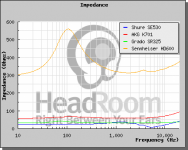Another question to ask the experienced...
I'm looking a way to reduce the volume output to the headphones (32-ohms and lower) without changing the gain of the amp.
I've seen adding resistors in series as some sort of impedance adaptor to make earphones sound better in some more fanatical forums.
But my primary concern is that, voice coils are inductors, and inductors have varying impedance depending on frequency, I'm guessing that impedance of a resistor is more or less the same at varying frequencies. That would mean the voltage will be divided differently at different frequencies, giving it some kind of strange equalization effect that may be thought of as "better sound" in other forums?
Would I be better of with this resistor or should I stick with lowering the volume digitally at the source?
I'm looking a way to reduce the volume output to the headphones (32-ohms and lower) without changing the gain of the amp.
I've seen adding resistors in series as some sort of impedance adaptor to make earphones sound better in some more fanatical forums.
But my primary concern is that, voice coils are inductors, and inductors have varying impedance depending on frequency, I'm guessing that impedance of a resistor is more or less the same at varying frequencies. That would mean the voltage will be divided differently at different frequencies, giving it some kind of strange equalization effect that may be thought of as "better sound" in other forums?
Would I be better of with this resistor or should I stick with lowering the volume digitally at the source?
Depends. What are you using for a headphone amp? I use a second hand Rotel RA-820AX integrated picked up cheap. The speaker out feeds an 8 ohm resistor in series with 1 ohm, the latter to ground. The headphones are across the 1 ohm resistor. The amp is happy with the load, the headphones see an almost purely resistive 1 ohm drive impedance from DC to well up into the RF range, the divider knocks down the amp's noise almost 20 dB while still allowing deafening volumes.
Using resistor at output ro reduce volume of headphone.
wwenze
A few helpful references.This time, not from a more "fanatical" forum.
SandyK
http://www.stereophile.com/features/808head/index2.html
http://www.epanorama.net/circuits/headphone_attenuator.html
http://sound.westhost.com/project70.htm
wwenze
A few helpful references.This time, not from a more "fanatical" forum.
SandyK
http://www.stereophile.com/features/808head/index2.html
http://www.epanorama.net/circuits/headphone_attenuator.html
http://sound.westhost.com/project70.htm
wwenze, before over-complicating things consider if there's anything 'fanatical' about understanding what happens to the frequency response of the headphones shown here when driven by 120 ohms. Checking with the manufacturer if your headphones are designed to the IEC 61938 spec is advisable before choosing an approach.
Attachments
Thanks, those impedance measurements sure answered my questions.
My headphone is a Alessandro MS-1, which I presume to be similar to Grado in terms of construction.
"Minor bun engine made benny lava"
😀
My headphone is a Alessandro MS-1, which I presume to be similar to Grado in terms of construction.
"Minor bun engine made benny lava"
😀
Using resistor at output to reduce volume of headphones.
wwenze
The AKG K701 can sound "edgy" with some amplifiers.
The attachment may help complete the overall picture.
SandyK
wwenze
The AKG K701 can sound "edgy" with some amplifiers.
The attachment may help complete the overall picture.
SandyK
An externally hosted image should be here but it was not working when we last tested it.
Last edited:
- Status
- Not open for further replies.
